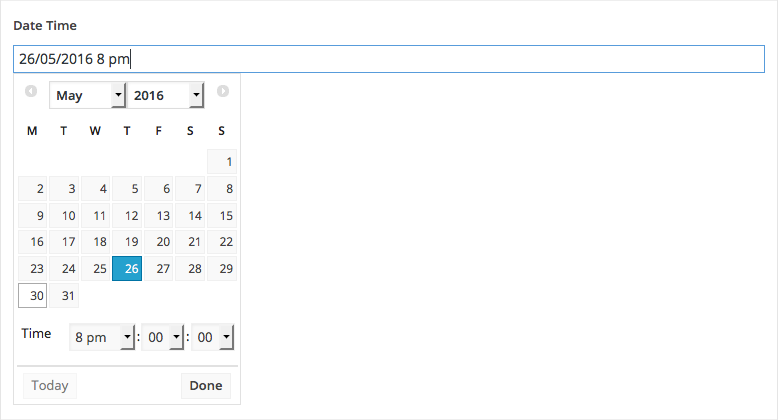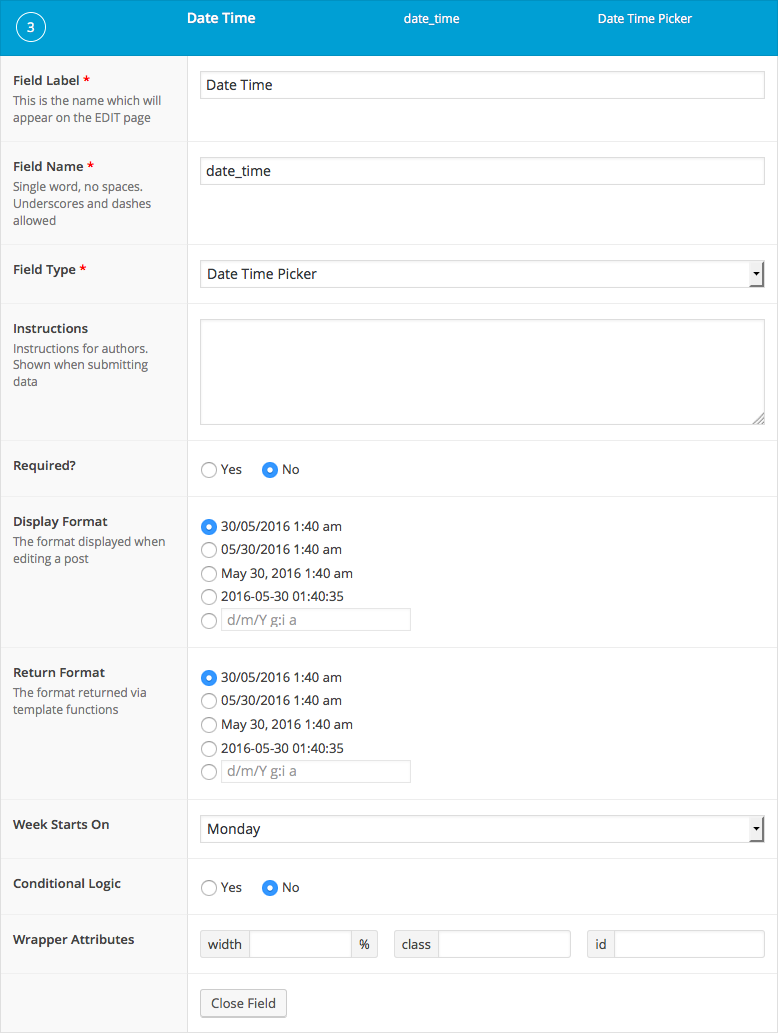Description
The Date Time Picker field creates a jQuery date & time selection popup.
Screenshots
Changelog
- Added in version 5.3.9.
Settings
-
Display Format
The date format that is displayed when selecting a date. -
Return Format
The date format that is returned when loading the value. Please note that the value is always saved asY-m-d H:i:s(YYYY-MM-DD HH:II:SS) in the database. -
Week Starts On
Specifies the day to start the week on.
Template usage
The Date Time Picker field returns a date-time string using the Return Format setting.
Display value
This example demonstrates how to display a date-time value.
<p>Event starts: <?php the_field('start_date'); ?></p>Query posts sorted in order
This example demonstrates how you can query posts sorted in order of a custom field value.
<?php
$posts = get_posts( array(
'posts_per_page' => -1,
'post_type' => 'event',
'order' => 'ASC',
'orderby' => 'meta_value',
'meta_key' => 'start_date',
'meta_type' => 'DATETIME',
));
if( $posts ) {
foreach( $posts as $post ) {
// Do something.
}
}Query posts within date range
This example demonstrates how you can query posts to find events that are currently happening today.
<?php
// Find todays date in Ymd format.
$date_now = date('Y-m-d H:i:s');
// Query posts using a meta_query to compare two custom fields; start_date and end_date.
$posts = get_posts( array(
'post_type' => 'event',
'meta_query' => array(
array(
'key' => 'start_date',
'compare' => '<=',
'value' => $date_now,
'type' => 'DATETIME',
),
array(
'key' => 'end_date',
'compare' => '>=',
'value' => $date_now,
'type' => 'DATETIME',
)
),
));
if( $posts ) {
foreach( $posts as $post ) {
// Do something.
}
}Query upcoming posts
This example demonstrates how to query and loop over upcoming events (in the next 7 days) ordered by a custom date time field value.
<?php
// Find current date time.
$date_now = date('Y-m-d H:i:s');
$time_now = strtotime($date_now);
// Find date time in 7 days.
$time_next_week = strtotime('+7 day', $time_now);
$date_next_week = date('Y-m-d H:i:s', $time_next_week);
// Query events.
$posts = get_posts(array(
'posts_per_page' => -1,
'post_type' => 'event',
'meta_query' => array(
array(
'key' => 'start_date',
'compare' => 'BETWEEN',
'value' => array( $date_now, $date_next_week ),
'type' => 'DATETIME'
)
),
'order' => 'ASC',
'orderby' => 'meta_value',
'meta_key' => 'start_date',
'meta_type' => 'DATETIME'
));
if( $posts ) {
foreach( $posts as $post ) {
// Do something.
}
}Save as unix timestamp
This example demonstrates how to change the value saved from the standard ‘Y-m-d H:i:s’ string to a unix timestamp number. This may be necessary to maintain compatibility with third party date time picker fields.
<?php
add_filter('acf/update_value/type=date_time_picker', 'my_update_value_date_time_picker', 10, 3);
function my_update_value_date_time_picker( $value, $post_id, $field ) {
return strtotime( $value );
}Notes
Database format
The value selected can be returned and displayed in different formats but will be saved to the database as ‘Y-m-d H:i:s’. This format is used throughout the WordPress database tables and will allow for straight-foward database querying.
Date format strings
To customize the Display Format and Return Format settings further, refer to the full list of date format strings within the DateTime::createFromFormat() documentation.
Date formats in JavaScript
Some JavaScript libraries might format PHP date strings differently. For example, the following date function in PHP:
echo date('F j, Y @ g:i a');Will output something like:
November 19, 2021 @ 1:49 pmHowever, if you pass this value to the somethign like the jQuery UI DatePicker Widget, it will see the @ as a special character to be formatted return the Unix timestamp, which is not ideal.
In order to fix this, you can use the acf/settings/php_to_js_date_formats filter, which will convert any instance of the @ symbol to '@', and thereby treated as a string in JavaScript, instead of a character to be replaced.
add_filter('acf/settings/php_to_js_date_formats', 'support_at_symbol_in_date_format', 10, 1);
function support_at_symbol_in_date_format($formats) {
$formats['@'] = "'@'";
return $formats;
}Translations
If you require the date to be displayed in a non English language, WordPress contains a function called date_i18n() which will perform the translation for you.
<?php
// Load field value and convert to numeric timestamp.
$unixtimestamp = strtotime( get_field('date') );
// Display date in the format "l d F, Y".
echo date_i18n( "l d F, Y", $unixtimestamp );Supercharge Your Website With Premium Features Using ACF PRO
Speed up your workflow and unlock features to better develop websites using ACF Blocks and Options Pages, with the Flexible Content, Repeater, Clone, Gallery Fields & More.
Related
- Field Types: Date Picker
- Field Types: Time Picker
- Choice: Button Group
- Field Types: Page Link
- Content: File



